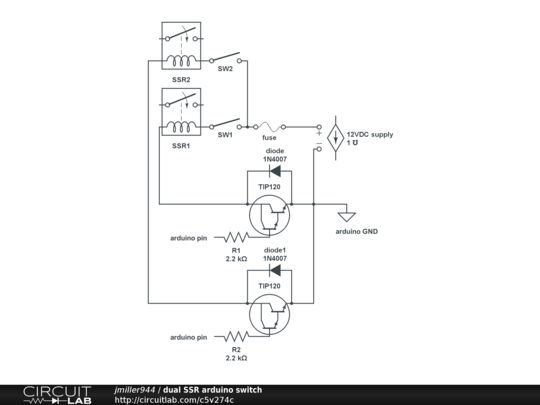Expansion request
-
Hi Lazer Denim, thanks for the advice. Too bad it's not possible to have a Onion expansion with heavier duty relay. I'll be sure to share the project when it's done.
-
Anders,
I don't have an onion relay expansion yet, but you could probably use it in place of this circuit I made to switch a Solid State Relay.
https://www.sparkfun.com/products/10636
I use this to switch Solid State Relays that drive 5500W heaters for my brewery.
You only need half of this to drive one relay. It will take 3-5VDC and step it up to 12VDC to switch the SSRs. I currently control this with an arduino, but plan to replace that with an onion soon.

https://www.circuitlab.com/circuit/5v274c/dual-ssr-arduino-switch/You need a Ground Fault protected breaker(GFCI) on the AC circuit! Don't attempt this is unless you know how to safely work with dangerous voltage! I can not be responsible for your safety! Make this at your own risk!
-
Thanks Jonathan! Looks like I will do something like that then.
-
I think I found something that's perfect for me : http://www.powerswitchtail.com
-
The PowerSwitch Tail II has an input range (3-12V) that exceeds what the Onion's GPIO can deliver, but I believe a few modifications to parts values (it is a kit) would allow the Onion to be used as a controller. I have contacted the manufacturer to verify if these modifications would be appropriate: Change the LED to a low-voltage, low current LED (1.7V @ 2mA, something like the Kingbright WP710A10LID), and also change R1 to 220 ohms and R2 to 150 ohms - see the kit's instructions at PowerSwitch Tail II
-
I needed to switch huge relays with my arduino. The circuit I posted is how I used a relay(TIP120 and transistor) to make a 3VDC output a 12VDC output. The two sides of the circuit are isolated. The big 240VAC relay is driven by the 12V side of the circuit.
Of course you only need half of the circuit to drive one relay.Although I haven't tried it yet, Could the Onion relay expansion be used in the same way?
The output from the expansion drives the input of the larger relay. Add a power supply of 12VDC, or whatever your big relay needs for input.
Also, add a kill switch, fuse, and GF protected outlet for AC, for safety's sake.
-
@Jonathan-Miller How much current is required for the big relay coils? The Relay Expansion Board's relay contacts are rated for 2A and 250VAC , with a switching power rating of 60W (dc) or 62.5VA (ac) - see another response to this question HERE.
-
@Jeff-Verive For my big relays I use Solid State Relays, opto-isloated, no coils. Mine are rated for 50a @240VAC. You should get relays rated for at least double the current you need.
Here are the input ratings on the relays I am using in my brewery to power 5500W water heater elements.
Control Voltage: 3-32V DC
Control Current: 5-25mA DC.
For input a basic old 12V DC 0.5a power supply is fine.Although my arduino should be able to switch the big relays directly, I prefer to use the opto-isolated 12V circuit to switch them.
-
I don't see why there should be any problems using the Onion's Relay Expansion Board relays to connect the SSR relay inputs to your 12V supply. The contacts are certainly adequate for this purpose.
-
@Jeff-Verive Agreed. Let us know how it goes!
I hope to switch over to an Onion controlled system for my brewery as soon as I get some spare time to work on it.
-
PowerSwitchTail has confirmed that the modifications I suggest should work fine with the Onion.
-
Thanks so much for that! I had totally overlooked the output voltage of the Omega. I suppose I would have noticed it sooner or later

I ordered the PSTK-240 but haven't received it yet. But do those modifications work for the 240vac version too?Edit: at last the package from powerswitchtail.com made some progress. Apparently it takes 2 weeks from Honolulu to New York

So I expect to receive the tails next week.
-
These modifications should be fine for either the 120Vac or 240Vac versions. The values for R1 and R2 are approximate values chosen with typical device tolerances in mind, and may need to be tweaked for a particular environment (especially at elevated temperature). You can omit R1 and the LED to increase the drive current for the PowerSwitch Tail II's input optocoupler, but you'll lose the visual indication of the unit's operating state. If you require the LED, it's important that you use a low-current LED; a regular LED may not light up sufficiently, and reducing R1 to improve LED brightness may drop the GPIO pin's output voltage too much (leaving insufficient current to drive the optocoupler).
-
With your modifications, am I locked to the output voltage of the Omega, or does the voltage range still go up to 5V on the powerswitch tail?
-
The input to the PowerSwitch Tail is an optocoupler, with an input current range of about 3 - 30mA at a forward voltage of about 1.4V in the "ON" state. The modifications I have proposed will allow the Omega (whose I/O circuitry runs off a 2.5V supply) to provide at least 3mA when ON. If a 5V input is used instead of the Omega, the input current (with these modifications) becomes about 15mA, which is still well within the operating range for the PowerSwitch Tail's input current.